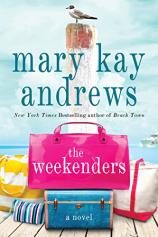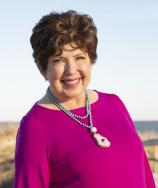Interview: May 19, 2016
Some people (everyone) refer to Mary Kay Andrews as the “Queen of the Summer Beach Read," while others (the Bookreporter staff) refer to her as “MKA.” Whatever you happen to call her, one thing's for sure: She knows how to deliver a compulsively readable summer book. In this interview, MKA talks to Carol Fitzgerald, the president and co-founder of The Book Report Network, about THE WEEKENDERS, another trademark beach read...with a dark twist. She discusses the importance of female friendship, how her ever-optimistic outlook finds its way into all her stories, and tips for decorating her summer homes --- which make it no wonder she’s so good at writing “house porn”!
Bookreporter.com: Belle Isle, North Carolina, the setting of your book, sounds idyllic. You so captured the details of a beach town available only by ferry and where, once on the island, the only transport is golf carts. Where did you do your research, and how much time did you spend there to get caught up in the ambience of the place?
Mary Kay Andrews: Belle Isle was loosely inspired by Baldhead Island, which is a real barrier island off the coast of North Carolina. I spent a long weekend there and experienced a Full Moon Party, which inspired events in the book. And then, of course, I did lots of reading and began pinning pictures of old beach houses on Pinterest.
BRC: THE WEEKENDERS opens on Memorial Day weekend, and Riley Griggs has a lot on her plate. Her husband does not meet her and her daughter, Maggy, as planned at the ferry. He is soon found dead, and later it is called a murder. They had planned to tell Maggy that weekend that they were divorcing. Wendell has left a trail of debt and fiduciary irresponsibility behind him. Riley’s home has been foreclosed on, and she must move in with her mother. Quickly we see that this is not going to be a quiet summer. Which element of the story did you have first?
MKA: I pretty much had the ferry scene planned in my head as soon as I arrived at the ferry terminal for Baldhead Island.
BRC: The mystery behind Wendell’s death is woven throughout the story. For years, you wrote mysteries under your real name, Kathy Trocheck. I think this is the first of your Mary Kay Andrews novels in which there is a definitive mystery plot. I loved it and wonder what inspired you to do this now.
MKA: I was having dinner with Jennifer Endlerlin, my amazing editor at St. Martin's Press, (or maybe it was lunch?), and we were discussing the plot for THE WEEKENDERS --- the title was her idea, by the way --- and she suggested I might want to kill somebody in this book. I knew immediately who the victim would be!
BRC: Female friends as cohorts are a part of each of your books. Here Riley has Parrish as her sidekick. Together they are a band of two against other snippy women who are gossips and looking to tear Riley down. You clearly embrace your own female friendships. What do you think women bring to one another?
MKA: I think great friendships can give women what they crave in life: bonding, warmth, affirmation, nurturing. Also, fashion advice.
BRC: THE WEEKENDERS has less “house porn” than many of your other books, but we still see your love of beautiful homes and things. When you are writing, do you love the moments when you can decorate the houses in your books? What pieces gave you the most joy in this one?
MKA: I loved describing Shutters, which is the Nolan family home on Belle Isle. I clipped a photo out of Architectural Digest of a real house on the New England coast, which inspired Shutters. But Nate's duck hunting cabin was also fun to write about, especially as I planned his "man cave."
BRC: Traditions of family vacations are part of this book. Seeing the lighthouse for the first time during the ferry ride, the Full Moon Parties, fireworks and so many other moments are special benchmarks of summer. Do you have a favorite summer beach tradition?
MKA: I love toasting the sunset with friends and family and looking for the "green flash" at my hometown Gulf beaches in St. Petersburg. On Tybee Island, where we have a vacation home called Ebbtide, I enjoy standing on our "coffee cup deck" and watching the sunrise in my PJs.
BRC: What inspired you to layer in that Maggy has type 1 diabetes? You definitely gave readers an education about the gravity of the disease and the balance that must come into play in one’s lifestyle.
MKA: My son's best friend and his father and little brother are diabetic, and Kevin's mother and I were baseball mothers together. She had to be on constant alert to monitor her family's health, and I think I absorbed some of that tension during all those innings we sat together in the bleachers. When I began writing about Maggy, I called her for help in the research.
BRC: Also, Billy’s alcoholism is a trial for the family. Again this was not something light. Was there a reason you wrote this into the story?
MKA: When you write about families, as I often do, you write about conflict and dysfunction, even in the happiest, most successful clans. Unfortunately, I think there aren't many contemporary families who aren't somehow touched by alcoholism. Billy is like a lot of adult alcoholics we all know: charming, talented and deeply flawed. He had a secret, and he didn't want to give it up to me until very near the story's end!
BRC: You once told me that you are very conscious of chapter length when you start writing. What’s your ideal word count? How do you make edits to keep them brisk, and why do you do that?
MKA: I was trained as a newspaper journalist, so when I started writing fiction, I told myself a chapter in a novel was probably about the length of a Sunday 1-A feature, which we used to call a "thumb-sucker," at around 2,000 words. So that's still my average chapter length, and I'm always aware of pacing and rhythm as a means to keep the reader turning the page.
BRC: Your books always end happy. Tell us why that is important to you.
MKA: I am, by nature, one of those relentlessly, annoyingly cheerful people. And I'm a Leo, which means I always, literally, move toward the light. I use darkness and shadowing in my work, because that's reality, but my end goal is always sunshine. Not perfection, certainly, but a feeling of optimism. I want to embrace and celebrate everyday joy in my life, and my readers tell me that's what they love about my work. So, who am I to argue?
BRC: Besides this book, you also wrote a novella this year, CHANGE OF SCENE, which is the prequel to BEACH TOWN. What inspired you to write that? And what can you tell readers about it?
MKA: After I handed in BEACH TOWN last year, my editor cruelly (but rightly) lopped off the first 75 pages of my manuscript. That material was my protagonist Greer Hennessy's backstory, about her colorful actress mother, Lise, and studio seamstress grandmother, Dearie, and their influences on her. Even though I was supposed to have moved on to tell Riley Nolan's story in THE WEEKENDERS, I just couldn't let go of Greer. So I began working in secret to develop the deleted material into a complete story. It was a relief to get it all down on paper and out into the world.
BRC: You own some homes at the beach and clearly love decorating them. Readers also can rent these out, and they come with a cool extra --- signed books by the author. What have you heard from readers who have stayed at your houses?
MKA: I've named the houses Breeze Inn and Ebbtide, after houses in my novels, and decorated them with the vintage rescues I find in my travels at estate sales and junk shops. Readers tell me they love moving into my world --- if only for a week or so. It gives me so much pleasure reading the notes they leave in our guestbook and finding the little gifts they hide for me.
BRC: Can you tell us what you are working on now and when readers might expect to see it?
MKA: I have a delicious secret project brewing for next year, but I don't want to jinx it by discussing it just yet!




